PROJECTS | Exhibitions
Studio 6 presents:
CAC Bukovje (SLO) & Studio Golo Brdo (CRO)
Exhibition, lecture, teatime
23 November-11 December 2011
Vžigalica Gallery, Trg franc. revolucije 7, Ljubljana
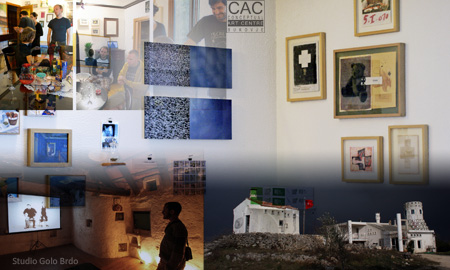
Tomislav Brajnović with selected artists from the exhibition program of Golo Brdo Studio: Nemanja Cvijanović, IRWIN, Dalibor Martinis, Vlado Martek and Goran Petercol.
Nina Slejko and Conny Blom from CAC Bukovje and their collection of contemporary art: Rasmus Albertsen, Bababa International, Donald Baechler, Conny Blom, Heath Bunting, Lado Darakhvelidze, Eric Doeringer, Carl Johan Engberg, Gilbert & George, IRWIN (Roman Uranjek), Lisa Jeannin & Rolf Schuurmans, Serkan Özkaya, Miha Perne, Magnus Petersson, Daniel Segerberg, Mladen Stropnik, Nina Slejko, Johan Wik, and Leon Zuodar.
Curated by: Saša Nabergoj, Sonja Zavrtanik
Assistant: Simona Žvanut
 The Studio 6 program was conceived in 2004 by Barbara Borčić and Saša Nabergoj at the SCCA-Ljubljana. We wanted to show all the diverse aspects of an art context, which contributes to how individual art works are interpreted, and encourage discussions on influential books, unfinished projects, dead-end ideas etc. We were interested in how individuals in the art world are inter-connected, while seeking to prompt debates between different protagonists – artists, curators and critics – not only about art works and exhibitions, but also the processes which lead to the final result. The Studio 6 program was conceived in 2004 by Barbara Borčić and Saša Nabergoj at the SCCA-Ljubljana. We wanted to show all the diverse aspects of an art context, which contributes to how individual art works are interpreted, and encourage discussions on influential books, unfinished projects, dead-end ideas etc. We were interested in how individuals in the art world are inter-connected, while seeking to prompt debates between different protagonists – artists, curators and critics – not only about art works and exhibitions, but also the processes which lead to the final result.
With the careful selection of participants at Studio 6, we created various situations through which we examined theoretically and practically various levels of work and cooperation in art. In the first year, we formed a team of five curators (Božidar Zrinski, Bojana Piškur, Iztok Hotko, Alenka Gregorič and Saša Nabergoj), who collaborated closely with their respective invited artist when preparing an exhibition and discussion in the Project Room. In the ensuing years, the focus was on the discussion - a discursive event which accompanied the exhibition - which was a site-specific intervention in the full (in terms of meaning and space) Project Room. We invited curators who had established interesting models of work and examined key issues – including Petra Kapš and Božidar Zrinski, who focused on the issue of the power of the curator and commissioned works, and Jurij Krpan, Nevenka Šivavec and Andrej Medved, whose working method is based on a close continuous following and collaboration with the artistic practice of an artist.
Thus, Studio 6 will venture out of the home venue which contributed to its establishment and name – the SCCA Project Room at Metelkova 6 – to become a guest of the Vžigalica Gallery. We have taken this opportunity to reflect on past work, and on the basis of previously tested formats seek to conceive a complex project: an exhibition of contemporary art and a space of collaboration in which curatorial and artistic practice and its perception are placed in context, allowing for a presentation of alternative ways of working and collaborating in the art world.
 |
- About exhibition
- CAC Bukovje
- Studio Golo Brdo
- Opening with accompanying event
- Press Clipping
- Colophon
1. About exhibition
We invited two artist-run spaces that promote a wider reflection on the methods and conditions of presenting works of art to participate. They are not interested in being spectacular, but in the long-term work of adjusting to local contexts. We invited CAC, the Conceptual Art Centre Bukovje (Slovenia) and Golo Brdo Studio (Croatia), whose inspired and constructive work we have been following for some time, to present curatorial and artists’ work and install an exhibition in the gallery.
The contribution of Golo Brdo Studio was conceived by Tomislav Brajnović, Saša Nabergoj and Sonja Zavrtanik, who have been collaborating in various ways for several years, while the presentation of CAC Bukovje was prepared in collaboration with the Centre’s founders Nina Slejko and Conny Blom; in this case, we hope that long-term collaboration will ensue.
Five artists who have previously collaborated with Golo Brdo Studio were participating in the exhibition: Nemanja Cvijanović, IRWIN, Dalibor Martinis, Vlado Martek and Goran Petercol. Each has been invited to contribute a work of their choice, which should be recent and modest in terms of production. This is in accordance with the conceptual guidelines of the program of Golo Brdo Studio.
CAC Bukovje will present their small, but outstanding art collection, which features great names from the world of contemporary art, and which was established by Nina Slejko and Conny Blom on the principles of the alternative economy (often involving exchanges of their own art works).
An archive and documentary section will screen the rich visual archives of both centres, and we will also set up a reading corner with their publications.
2. CAC Bukovje
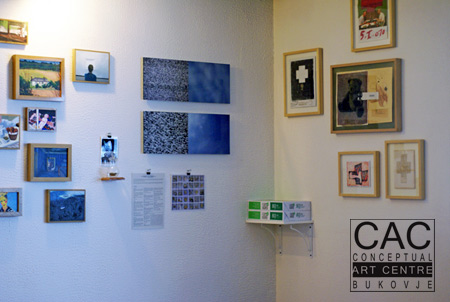
CAC Bukovje
Selection of works from the CAC Bukovje collection
Artists:Rasmus Albertsen (1978, Denmark), Bababa International (group formed in 2008, Australia), Donald Baechler (1956, USA), Conny Blom (1974, Sweden), Heath Bunting (1966, UK), Lado Darakhvelidze (1977, Moldavia), Eric Doeringer (1974, USA), Carl Johan Engberg (1977, Sweden), Gilbert & George (1942, 1943 UK), IRWIN – Roman Uranjek (group formed in 1983, Slovenia), Lisa Jeannin (1972, Sweden) & Rolf Schuurmans (1972, Nederlands), Serkan Özkaya (1973, Turkey), Miha Perne (1978, Slovenia), Magnus Petersson (1971, Sweden), Daniel Segerberg (1972, Sweden), Nina Slejko (1982, Slovenia), Mladen Stropnik (1977, Slovenia), Johan Wik (1975, Sweden), Leon Zuodar (1977, Slovenia)
Many art collections are built out of love for art. And then there are those who are assembled as an investment. A well selected art collection can serve to represent the profile of an institution or the taste of a private collector, but a collection is also a signifier of status. As such, it is very much part of a hierarchic system, one that strives to manifest positions and maintain order. It is a capitalist structure where art is treated as stocks and thereby a target for speculation. Within such a structure a gallery might reject a buyer if her/his collection does not have enough status and thus cannot further the economic value of the piece by its inclusion in their collection. A collector can also effectively sabotage an artist’s career if she/he decides to sell off the works of a specific author. Artists are very much at the mercy of the players within this system, but at the same time, the artists should preferably not stress any commercial aspirations of their own publicly. Nobody wants to hear that the higher goal with an art piece is to successfully place it within a market system. Ideally, the artists should have idealistic reasons for making their work, and it should be executed according to a politically leftist agenda with an oppositional stance against established power structures. But of course, at the same time, the artist should in reality comply with the system.
There is only one thing a rampaging capitalist system cannot deal with. It is called "for free". The capitalist strategies of domination are basically based on two actions, raising or lowering prices. There is no way of opposing something that is offered for free. In 2006 British authorities were severely upset with Mozilla when they figured out that the organisation was giving their Firefox browser away for free. As they stated, if companies like Mozilla give away their software for free, it becomes very difficult for the authorities to enforce UK anti-piracy legislation. In other words: only if everything has a price, the system can function smoothly. As soon as one starts giving things away for free, one becomes a threat to the order. It is in fact rather easy to defy the system, as long as one is all right with being poor. And judging by how many people have little choice in the matter and have to be poor whether they like it or not, perhaps the world is quite ready for an alternative economy.
The CAC Bukovje collection is solemnly based on donations, personal gifts and trades. No money has changed hands, building the collection.
Nina Slejko and Conny Blom
List of exhibited works with explanations where needed
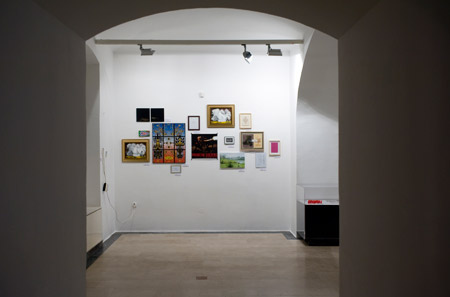
Exhibited collection
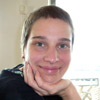 Nina Slejko (1982) has obtained a Master's Degree at the Valand School of Fine Arts in Gothenburg (Sweden) in 2009. She displayed her work at many important exhibitions, such as SIK - spridd isolerad konst in the Kalmar Konstmuseum, and with many established artists, such as Lawrence Wiener, Jimmie Durham, Daniel Pflumm et al. (2009), Qui Vivre? 2 (2010). She took part in the second international young art Nina Slejko (1982) has obtained a Master's Degree at the Valand School of Fine Arts in Gothenburg (Sweden) in 2009. She displayed her work at many important exhibitions, such as SIK - spridd isolerad konst in the Kalmar Konstmuseum, and with many established artists, such as Lawrence Wiener, Jimmie Durham, Daniel Pflumm et al. (2009), Qui Vivre? 2 (2010). She took part in the second international young art
biennale in Moscow together with artists Gardar Eide Einarsson, Carlos
Motta, Olivier Babin et al. In the recent years she exhibited her
works in Slovenia at the Ganes Pratt gallery and the International
Centre of Graphic Arts (MGLC). Together with Swedish artist Conny Blom
she founded the Contemporary Art Centre CAC Bukovje. For more info: www.ninaslejko.com.
CV (pdf)
 Conny Blom (1974) is a Swedish artist who has made or participated in more than 80 exhibitions and he has exhibited with artists like Rodney Graham, Jenny Holzer and Daniel Buren. With a background as an art historian, Blom deals with the defining issues of our modern society, our living conditions and the rights of the individual versus the society and the economical forces. Trying to balance between the poetic and the subversive, Blom uses material from pop culture as well as iconic pieces of contemporary art to comment, question and subvert established hierarchies. For more info: www.connyblom.com. Conny Blom (1974) is a Swedish artist who has made or participated in more than 80 exhibitions and he has exhibited with artists like Rodney Graham, Jenny Holzer and Daniel Buren. With a background as an art historian, Blom deals with the defining issues of our modern society, our living conditions and the rights of the individual versus the society and the economical forces. Trying to balance between the poetic and the subversive, Blom uses material from pop culture as well as iconic pieces of contemporary art to comment, question and subvert established hierarchies. For more info: www.connyblom.com.
CV (pdf)
3. Studio Golo Brdo
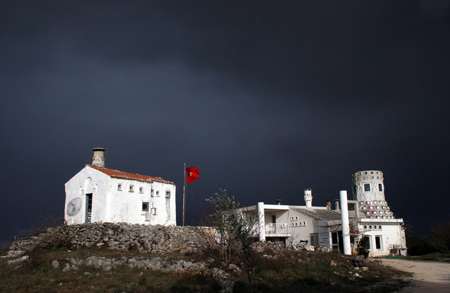
Studio Golo Brdo is situated on a hill previously called Gumila. It was a desolate place, a pile of stones which were brought by local people in ancient times to mark the graveyard. There were also prehistoric tombs found on this very site.
Gumila was a place where nobody wanted to go alone, especially at night. Children were frightened of the place.
But it is precisely at that place that my father decided to build his Studio as a Space Centre for Painting. At the time, his idea was perceived as a bit mad, but with time people began to believe my father will be able to make it.
In the 60s he started to build a small house on the pile of stones mentioned before. The small house looked more as a small desolated church on a hill-top than an artist studio. In the centre of the building he placed the teacher's stone chair with stone benches on the left and right side for the students to sit on.
Later he built another, much larger building that he now uses as his living and working space.
The small house Mala Gumila (Small Gumila) was given to me to use it as a studio. After finishing my MFA in London I came back to Rovinjsko Selo and visited an exhibition in Sikuti, organized by the artist group Sikuti Machine. I was amazed by the speed with which the group did their work, their elegant way of solving problems and the complete non-institutional framework. It was a shock after the London's chaotic experience.
I recognized the need to enrich the art scene of Istria and Croatia by beginning a new art project entitled Studio Golo Brdo. At the same time it would finally be the fulfilment of my father’s idea to establish an Art Centre on the Gumila which was later renamed to Golo brdo (Naked Hill).
The project had successfully continued its activity until 2011 when the decision was made to change the structure of the project in 2012 and introduce a Residency program for one artist chosen on the basis of an open call, in addition to the three regular annual exhibitions.
Tomislav Brajnović
 Tomislav Brajnović Tomislav Brajnović
Born 1965 in Zagreb. He completed the first year of studies at the KABK Den Haag in 1993. He graduated on the Academy of Fine Arts in Zagreb in 1999. He finished the MA Fine Art Course, St Martins College (London) in 2003. He was an assistant (2007–2008) and senior assistant (2008–2010) on Art Academy (Rijeka). Member of Croatian Association of Visual Artists (HDLU) and Croatian Association of Contemporary Artists (ZSUH).
Artists:
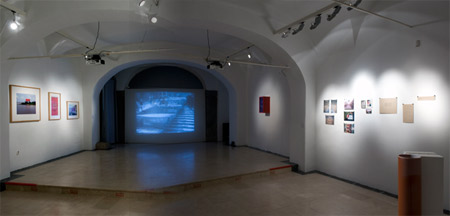
Exhibited works
4. Opening with accompanying event:
5. Press Clipping (doc)
6. Colophon
Production: SCCA-Ljubljana
Co-production: Museum & Galleries of Ljubljana
The project is supported by: City of Ljubljana – Department of Culture, Ministry of Culture of the Republic of Slovenia, City of Rovinj
Acknowledgements: International Centre of Graphic Arts (MGLC)
|

